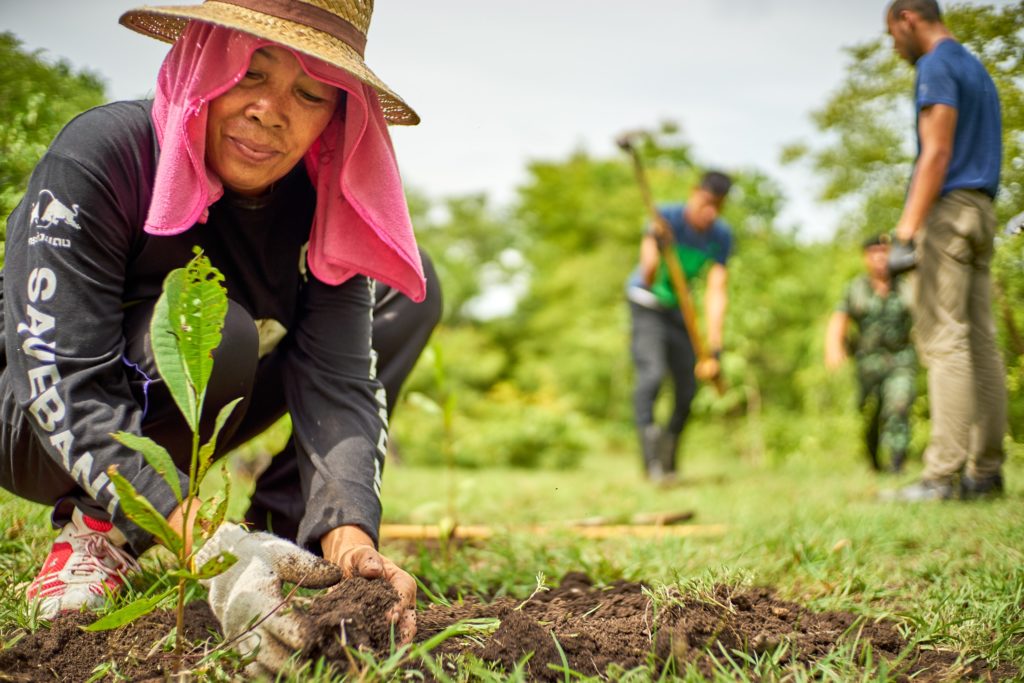Climate Action
Women’s empowerment is key to reducing climate change
March 6, 2020
Empowering women and girls in developing countries ranked second among 76 solutions for curbing global warming to 2 degrees Celsius, according to a new report by the climate research organization Project Drawdown. Drawdown estimates that girls’ education and family planning would reduce carbon by 85 gigatons by 2050. The report comes just before International Women’s Day on March 8.
Gender equality in health and education hasn’t received much public attention as a climate solution, even though it’s been on the global sustainability radar for years. In 2015, the United Nations included “achieve gender equality and empower all women and girls” in its 17 Sustainable Development Goals.
“We cannot comprehend how we are going to bypass climate issues without a gender lens,” Patricia Biermayr-Jenzano, a gender and agriculture specialist at Georgetown University who has worked for U.N.’s Food and Agriculture Organization, told Earth Day Network.
But how does gender equality reduce emissions?
With access to education, family planning and birth control, women have the ability to choose how many children to have and when they have them. The report shows that with this access, women have less children and have them later in life. In both rural and urban areas, slower population growth relieves stress on ecosystems, allowing resources to recover from overuse without compromising local food access.
With these additional resources, women also earn more money, achieve career goals and face fewer health issues. Rural women see higher crop yields, providing better nutrition and financial stability for their families.

The report also emphasizes that these efforts are not about enforcing population control — they’re about women’s freedom of choice. Drawdown explains, “When family planning focuses on healthcare provision and meeting women’s expressed needs, empowerment, equality, and well-being are the result; the benefits to the planet are side effects.
Unique contributions of women
But slowed population growth isn’t the only sustainable benefit to empowering women. Women also hold valuable knowledge for adapting to climate change.
In farming, men usually control finances, so they mass produce specific crops that drain soil nutrients. But because women grow and cook food for the household, they cultivate more varieties for taste and nutrition, protecting both biodiversity and soil resilience against droughts, floods and disease.
Climate change threatens the reliability of our food system, even as our population increases. The U.N. Food and Agriculture Organization estimates that to feed everyone on Earth, we need to increase food production by 70% by 2050. This dramatic increase will require innovative technology, healthy biodiversity and more (wo)manpower.
But when women can’t access loans, political office or land ownership, that means half the population is left out of the workforce and sustainability decisions.
“We need to equalize the field to allow women to perform,” Biermayr-Jenzano said. “It’s not only a human right, it’s to be intelligent. Because if 50 percent of the population is underperforming, the economy is not going to flourish. Women’s economic empowerment is empowering society.” .
Resilience against climate change
Project Drawdown also explains that education increases the resilience of women and girls to climate disasters. Because of traditional gender roles, legal inequality and financial barriers, women face unique risks as climate change intensifies natural disasters and raises food and water prices.
“When there are weather events like tsunamis and floods, women are not able to overcome those situations because they have to take care of the children or the elderly, they don’t know how to swim, they don’t know how to climb the trees,” said Biermayr-Jenzano.
For example, when a tsunami devastated Southeast Asia in December 2004, about 75% of the people who died were women. As climate change increases the frequency and intensity of extreme weather events, women aren’t able to protect themselves.
Additionally, in rural areas, women and girls are tasked with collecting water for their family. But as droughts and water scarcity increase, women and girls must spend more time and energy collecting water instead of earning money or attending school.
As climate change shifts our ecosystems and weather patterns, women will bear more of the brunt, further preventing them from achieving their potential.

Strategies to protect and empower women
With evidence and support from the U.N. and Project Drawdown, NGOs and governments are implementing several models to improve gender equality in sustainable development.
The Population, Health, and Environment model focuses on providing reproductive education and contraception in developing countries. This reproductive freedom will lead to personal and financial independence for women, food and nutrition security for families and less stress on local ecosystems.
In agriculture, nutrition-smart and climate-smart agriculture emphasize the knowledge and legal rights of female farm owners to empower them, improve family health and protect the future of our food.
But Biermayr-Jenzano says the most important model is considering gender in all development projects: “There is no such thing as gender-blind programs. Gender is a core issue for development, and without it we will waste a lot of time, investment and people.”
The International Development Research Center has adopted a 4-step approach for projects to consider gender at all levels. Projects aim to be:
- Gender-aware — including local women in their research
- Gender-sensitive — accounting for gender in the project design
- Gender-responsive — positively impacting local women
- Gender-transformative — contributing to a more equal society
“We have changed the concept of development, we are not only looking at sustainable development, we look at the whole system,” said Biermayr-Jenzano. “We know that nutrition, climate, agriculture, and environment are all tied up. And women are an important part of that fabric.”
On April 22, 2020 — the 50th anniversary of Earth Day — millions will take to the streets to demand climate action. Join us to fight for gender equality and climate justice.
Image at top: Women in Côte d’Ivoire Celebrate International Women’s Day. Photo credit: UN Photo/Ky Chung
